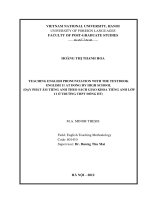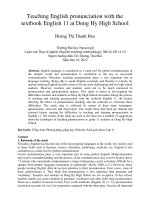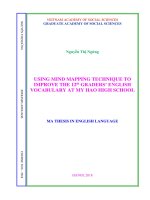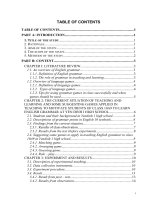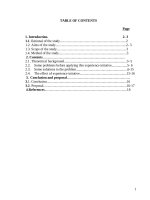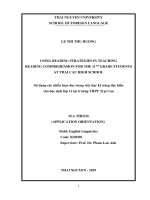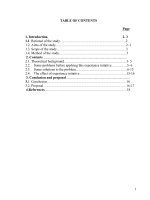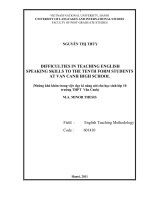Teaching English pronunciation with the textbook English 11 at Dong Hy High School = Dạy phát âm tiếng Anh theo sách giáo khoa tiếng Anh lớp 11 ở trường THPT Đ
Bạn đang xem bản rút gọn của tài liệu. Xem và tải ngay bản đầy đủ của tài liệu tại đây (783.2 KB, 57 trang )
VIETNAM NATIONAL UNIVERSITY, HANOI
UNIVERSITY OF FOREIGN LANGUAGES
FACULTY OF POST-GRADUATE STUDIES
HOÀNG THỊ THANH HOA
TEACHING ENGLISH PRONUNCIATION WITH THE TEXTBOOK
ENGLISH 11 AT DONG HY HIGH SCHOOL
(DẠY PHÁT ÂM TIẾNG ANH THEO SÁCH GIÁO KHOA TIẾNG ANH LỚP
11 Ở TRƯỜNG THPT ĐỒNG HỶ)
M.A. MINOR THESIS
Field: English Teaching Methodology
Code: 601410
Supervisor: Dr. Dương Thu Mai
HÀ NỘI - 2012
VIETNAM NATIONAL UNIVERSITY, HANOI
UNIVERSITY OF FOREIGN LANGUAGES
FACULTY OF POST-GRADUATE STUDIES
HOÀNG THỊ THANH HOA
TEACHING ENGLISH PRONUNCIATION WITH THE TEXTBOOK
ENGLISH 11 AT DONG HY HIGH SCHOOL
(DẠY PHÁT ÂM TIẾNG ANH THEO SÁCH GIÁO KHOA TIẾNG ANH LỚP
11 Ở TRƯỜNG THPT ĐỒNG HỶ)
M.A. MINOR THESIS
Field: English Teaching Methodology
Code: 601410
HÀ NỘI - 2012
iv
TABLE OF CONTENTS
DECLARATION i
ACKNOWLEDGEMENTS ii
ABSTRACT iii
TABLE OF CONTENTS iv
LIST OF CHARTS AND TABLES vii
PART I: INTRODUCTION 1
1. Rationale of the study 1
2. Aim and objectives of the study 1
3. Scope of the study 2
4. Methods of the study 2
5. Significance of the study 2
6. Design of the study 3
PART II: DEVELOPMENT 4
CHAPTER 1: LITERATURE REVIEW 4
1.1. Definition of pronunciation 4
1.2. The importance of teaching pronunciation 4
1.3. English pronunciation teaching to foreign language learners 5
1.3.1. What to teach 5
1.3.2. Approaches to teach 6
1.3.3. Methods to teach 7
1.3.4. Teaching techniques 8
1.3.5. Studies on the effects of different teaching methods 9
1.4. The teaching of English consonants 13
1.4.1. General description and classification of English consonants. 13
1.4.2. Vietnamese consonants 15
1.4.3. English vs Vietnamese consonants and the possible difficulties 16
1.5. Factors affecting the effects of pronunciation teaching 18
1.5.1 The native language 18
1.5.2 The age factor 19
v
1.5.3. Amount of exposure 19
1.5.4. Phonetic ability 19
1.5.5. Attitudes and personalities 20
1.5.6. Motivation 20
CHAPTER 2: THE STUDY 21
2.1. An overview of the situation of teaching and learning English at Dong Hy
High School 21
2.1.1. The educational environment 21
2.1.2. Teachers 21
2.1.3. Learners 22
2.1.4. The textbook 22
2.2. Research questions 23
2.3. Research methodology 24
2.3.1. The subjects of the study 24
2.3.2. Methods and procedures 24
2.4. Data analysis process 24
2.5. Summary 26
CHAPTER 3: DATA ANALYSIS AND DISCUSSIONS 27
3.1. The teachers and students‟ attitudes towards teaching and learning pronunciation 27
3.1.1. Questionnaires 27
3.1.2. Interview 29
3.1.3. Summary 30
3.2. The techniques used in teaching pronunciation 30
3.2.1. Questionnaires 30
3.2.2. Interview 31
3.2.3. Class observation 31
3.2.4. Summary 32
3.3. The levels of difficulties in teaching and learning pronunciation 33
3.3.1. Questionnaires 33
3.3.2. Interview 34
vi
3.3.3. Summary 34
3.4. The causes of the difficulties in teaching and learning pronunciation 34
3.4.1. Questionnaires 34
3.4.2. Interview 36
3.4.3. Summary 36
CHAPTER 4: FINDINGS AND IMPLICATIONS 38
4.1. Findings 38
4.2. Implications 39
PART III: CONCLUSION 42
1. Conclusions of the study 42
2. Limitations of the study 42
3. Suggestions for further study 43
REFERENCES 44
APPENDICES
APPENDIX 1: QUESTIONAIRE FOR STUDENTS I
APPENDIX 2: QUESTIONAIRE FOR TEACHERS III
APPENDIX 3: INTERVIEW V
APPENDIX 4: CLASSROOM OBSERVATION SHEET VI
vii
LIST OF CHARTS AND TABLES
Chart 1: Importance of pronunciation to students and teachers
Chart 2: Teachers and students‟ interest in pronunciation in class
Chart 3: Teachers and students‟ feeling towards the task of pronunciation in the
textbook English 11
Chart 4: The levels of difficulties in teaching and learning pronunciation
Chart 5: The causes of the difficulties in teaching and learning pronunciation
Chart 6: The causes of the difficulties in teaching and learning pronunciation with the
textbook English 11
Table 1: Consonants of English, (Kelly, 2000)
Table 2: Vietnamese consonants of Hanoi dialect
Table 3: Pronunciation matters mentioned in English 11
Table 4: The purpose of teaching and learning pronunciation
Table 5: Frequency of the techniques used in teaching pronunciation
Table 6: Pronunciation matters students and teachers find difficult to learn and teach
1
PART I: INTRODUCTION
1. Rationale of the study
Nowadays English has become one of the most popular languages in the world.
It is widely used in many fields such as business, science, education, technology,
medicine, etc. English is also considered as a main tool for global communication.
Correct pronunciation plays a very important part in using spoken English.
Mispronunciation may lead to misunderstanding and the process of the communication
may even be broken down. “A learner who consistently mispronounces a range of
phonemes can be extremely difficult for a speaker from another language community
to understand” (Kelly, 2000, p.11). However, many people learning English often do
not pay attention to their pronunciation. Even worse, some of them underestimate it.
They think that pronunciation is less important than grammar and vocabulary.
Teachers and students at Dong Hy High School are not exception. In this school,
teachers usually pay more attention to grammar, vocabulary and other skills than
pronunciation. There are a number of reasons for this. First, in the textbooks (English
10, 11, 12), pronunciation instruction accounts for very low proportion compared with
the other parts. Second, all important English exams at schools as well as the entrance
exam to universities are always in written form so most teachers and students have
little motivation to teach and to learn pronunciation. Third, it is more difficult for
students to get a mark from pronunciation than other parts .From the real teaching and
learning situation at Dong Hy High School, The researcher would like to carry out a
study to clarify some difficulties in teaching and learning pronunciation, the reasons
for them and suggest some solutions to the problems.
2. Aim and objectives of the study
This study is aimed at investigating the situation and difficulties in teaching and
learning pronunciation with the textbook English 11, the reasons for them and then at
suggesting the solutions to help teachers and students overcome these difficulties. In
order to achieve this aim, some objectives are posed for exploration as follows:
- To find out the attitudes of teachers and learners towards teaching and
learning pronunciation at Dong Hy High School.
2
- To find out how pronunciation is taught at Dong Hy High School.
- To find out the difficulties and the causes of difficulties in teaching and
learning Pronunciation in Language focus periods - English 11.
3. Scope of the study
Pronunciation is a large area of language teaching and often causes learners and
teachers a lot of difficulties and there is a limited time; therefore, this research is aimed
at investigating only the difficulties in teaching and learning pronunciation with the
textbook English 11that teachers and students at Dong Hy High School have been
facing and finding out the causes of these difficulties. Besides, the study is also to
suggest some implications for the teaching of pronunciation matters designed in
English 11, English consonantal matters.
4. Methods of the study
Both qualitative and quantitative methods are used in this study. Besides, many
resources such as books, magazines, articles, newspapers and some sources on the
internet are reviewed by the researcher.
In order to gain the most reliable results, the quantitative data are collected
through a survey questionnaire for 6 teachers and 100 grade 11 students at Dong Hy
High School.
Along with the quantitative method, the qualitative data are obtained in
classroom observation and interviews with some students and teachers to collect
further information.
After that, the results obtained from questionnaires, interview and observation
are discussed then some useful pronunciation teaching techniques are recommended.
5. Significance of the study
The textbook English 11 was designed with the hope that students could have a
complete insight into English consonantal sounds. However, there has not been much
investigation into the fact that whether lessons of pronunciation are suitable and
comprehensible for students; or whether the teaching of pronunciation for students of
grade 11 is easy- undertaken. This research provides an insight into the difficulties that
are often met by teachers teaching English for grades 11 in Dong Hy High School. In
3
addition, this research also points out some feasible solutions which are, hopefully,
beneficial for both teachers and students.
6. Design of the study
The study is divided into three parts:
The first part “Introduction” presents the rationale, the aim and objectives, the
scope, the methods, significance and the design of the study.
The second part “Development” consists of four chapters:
Chapter 1 provides a thorough literature review relevant to the study. It presents
the theoretical background: the concepts relating to pronunciation, importance of
teaching pronunciation, English pronunciation teaching to foreign language learners,
factors affecting pronunciation teaching. Teaching of English Consonants is also
mentioned in this chapter.
Chapter 2, chapter 3 constitutes the body of the study. Chapter 2 is the study
description with an overview on situation of teaching and learning English at Dong Hy
High School, research questions, and research methodology and data analysis process.
Chapter 3 presents the data analysis results and discussions.
Chapter 4 concludes the findings the researcher has found from the study and
proposes some solutions to the teaching of pronunciation for grade 11 at Dong Hy
High School.
The last part of the study “Conclusion” gives a brief description of the study
and states the limitations as well as the recommendations for further study.
4
PART II: DEVELOPMENT
CHAPTER 1: LITERATURE REVIEW
1.1. Definition of pronunciation
The concept “Pronunciation” is defined in different ways.
- According to Ur (1996, p. 47) “The concept of “pronunciation” may be said to
include sounds of the language or phonology; stress and rhythm; intonation;
combination of sounds; linkage of sounds".
- According to Zawadzki (1994 ), “pronunciation refers to the production of
sounds that we use to make meaning. It includes attention to the particular sounds of a
language (segments), aspects of speech beyond the level of the individual sound, such
as intonation, phrasing, stress, timing, rhythm (suprasegmental aspects), how the
voiced is projected (voiced quality) and in its broadest definition, attention to gestures
and expressions that are closely related to the way we speak a language”
In this study, the researcher has no intention of pointing out which definition of
pronunciation is the most precise but only wishes to find an appropriate definition to
facilitate the understanding of pronunciation in language study. Therefore, the
definition of pronunciation proposed by Ur (1996) is adopted.
1.2. The importance of teaching pronunciation
Learning and using the correct pronunciation are important, so teaching
pronunciation is significant as well.
According to Hasimanoglu (2006), pronunciation teaching is a prominent factor
in foreign language teaching. And sounds play an important role in communication,
so foreign language teachers must attribute proper importance to teaching
pronunciation in their classes
Harmer (2007) notes that learners should utilize pronunciation good enough for
them to be comprehended. However, while learning pronunciation, learners could
encounter difficulties to hearing the sounds. According to Harmer, teachers could
solve these problems by showing learners to how sounds are produced via
demonstration and explanation. Furthermore, after solving this problem, students‟

